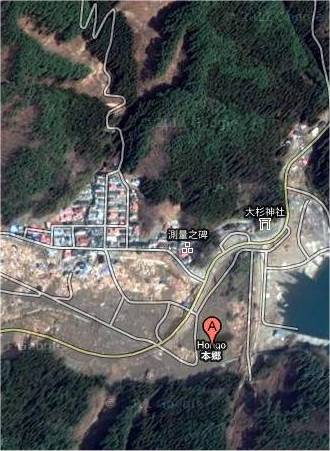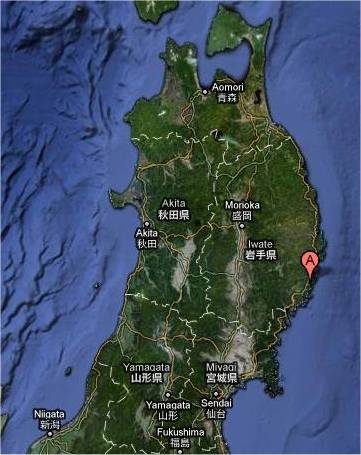[ed. Kazue Daikoku, the publisher and editor of "Happa-no-Kofu," wrote this piece at the request of Guido Monte. She indicated that her English was not perfect or as smooth as native English writers, but she hoped that she could convey her sentiments, as a Japanese woman, regarding the disastrous events that have befallen the northern region of her country. We think that in her own style she created a very sensitive piece and we hope readers will appreciate her unique Japanese perspective. (We've taken the liberty to begin her piece with a dramatic video of the damages caused by the tsunami that is posted on YouTube, which hopefully will work -- nothing lasts long on YouTube...)]
"Tsunami attacking in Minami-Sanriku"
(Swans - April 25, 2011) I think there is always a watershed that divides your destiny between good luck and bad luck. The areas, Sanriku seacoasts in Tohoku, which suffered damage on March 11 from the earthquake and the tsunami have been known as earthquake-prone zones. Basically the Japanese Archipelago is one of the world's most seismologically-active areas. We knew it very well...but I think we should have known better and become aware of it more.
I was translating a short story in English into Japanese for our new project when the first shake occurred on that day. I live in the suburbs of Tokyo about 200 miles far from the earthquake center. The shakes were so strong, which I've never experienced, and they continued for a long time, so I felt like it wouldn't stop. When the shakes finally stopped I soon took the remote control to turn on the TV.
On the screen NHK, state channel, repeated an alert about the tsunami; they informed the viewers the estimated tsunami's height of each area and alerted them to escape from the tsunami repeatedly. I realized the earthquake happened somewhere in Tohoku district, the northern part of Japan, but I felt something strange and irritated because they didn't say anything about my place. "Why don't they say anything?" Usually, when earthquakes happen, they say immediately where the shaking places are, how large it is, where the earthquake center is, etc. But that day they didn't say anything about other places and how big or where the center was -- they only repeated the tsunami alarm. Later I understood why they did so; it was the most major emergency; the tsunami had an extraordinary power we've never experienced.
But actually, the 2011 Tohoku earthquake and tsunami is the fifth bigger one since the Edo period. The previous ones occurred in 869, 1611, 1896, and 1933. "Large tsunamis have frequently struck the Pacific coast of the Tohoku district. The well-documented 1896 Sanriku tsunami had a maximum height of 38 mètres and caused more than 22,000 deaths. The 869 Jogan tsunami is documented to have had a height roughly comparable to, or perhaps slightly less than, that of the 11 March tsunami." (by professor Robert J. Geller of the University of Tokyo, from Nature) I wonder if people living there knew about these big tsunamis and the big damages. Of course they knew at least the latest one, I guess.
I heard about a small settlement named Hongo, which was left unharmed when the tsunami came to the Iwate coast this time. The residents had moved to the hill from the lower zone where they lived after the big tsunami came and created damage in 1933. All the houses of the settlement were completely destroyed by the big tsunami at that time and they decided to make a new settlement on the hill; about 100 houses moved to the hill, they migrated in schools. But in this village another 50 households that recently moved to this area and built their houses in a lower zone near the coast were all swallowed by the tsunami. Another coastal settlement in Iwate once had discussed about moving to the hill but couldn't decide their migration because the fishermen opposed leaving the seaside.

Kamaishi-Iwate Google map |

Tohoku district Google map |
I can imagine it may be difficult to leave their living places for village inhabitants like farmers and fishermen. But on the other hand I also think that they could move to the hill to avoid houses suffering tsunami damage. If all the inhabitants in Sanriku seacoasts had moved to the hill the disaster damages wouldn't have been catastrophic. It may be a pity that they couldn't learn from past experiences.
As for the Fukushima nuclear power plant accident the officials said that the Tohoku earthquake and tsunami was such a strong and "unforeseeable" event that they couldn't avoid the disorderly situation. But later we learned that the Tokyo Electric Power Company didn't have enough security systems in the plant; they underestimated the power of the tsunami by their wishful thinking, and didn't pay substantial cost for that. Nuclear energy in our country has been developed by the former government, the Liberal Democratic Party, and passed to the present one, the Democratic Party of Japan. I heard that the near perfect security system for a nuclear plant would cost too much to pay, so if power companies would pay it they couldn't manage their business, or the consumers would have to pay too much electricity expense. I guess people would not allow the costs to go up. If I look at things pessimistically we may choose to take the risk of being exposed to radiation rather than pay for expensive electricity.
Fukushima fell far behind other prefectures in industries in the 1960s. It was Japan's high-growth period at that time. To advance economy and industry, and bring wealth to Fukushima, they accepted to build a nuclear power plant. Of course the officials explained that the nuclear power plant had a perfect security system even if something happened, and people believed it, but they were gulled by their wishful thinking. The electrical power that the Fukushima nuclear power plant produce supplies the Kanto area, several prefectures including Tokyo, not to the people of Fukushima.
I wrote about a watershed at the beginning of this article. I ask myself again what divides one's destiny between good luck and bad luck, where the point of division is among the things. I hope all the people in Japan, including all the victims, would accept an independent role as the central players of this disaster. No one can be a mere pitiful and innocent victim. We are always involved with the society and the world in some ways, and a certain percentage of responsibilities are ours, even if it was a natural disaster. Were this not the case we are not civilized nor democratic people. The Japanese may tend to think that natural disasters are an inevitable fate, so "it's not our fault or anybody's fault, and what we can do is just endure a miserable situation." Do you agree with this way of thinking?
It's difficult for me to agree with it, and I would say all the disasters have some "human-generated disaster" aspect.
Several years later you will see what the Japanese actually are in the re-established places; how we rehabilitate the areas and the societies razed by catastrophic damages.
If you find Kazue Daikoku's work valuable, please consider helping us
Legalese
Feel free to insert a link to this work on your Web site or to disseminate its URL on your favorite lists, quoting the first paragraph or providing a summary. However, DO NOT steal, scavenge, or repost this work on the Web or any electronic media. Inlining, mirroring, and framing are expressly prohibited. Pulp re-publishing is welcome -- please contact the publisher. This material is copyrighted, © Kazue Daikoku 2011. All rights reserved.
Have your say
Do you wish to share your opinion? We invite your comments. E-mail the Editor. Please include your full name, address and phone number (the city, state/country where you reside is paramount information). When/if we publish your opinion we will only include your name, city, state, and country.
About the Author
Kazue Daikoku is the publisher and editor of a nonprofit Japanese Web Press, "Happa-no-Kofu," which means "leaf miner" in English (an insect larva that lives and feeds within a leaf). Happa-no-Kofu specializes on bilingual (Japanese-English) publications both on the Web and in print on demand. Daikoku writes in the site's about page, "We value the uniqueness of each individual's ideas. We support the individual's power and energy, and believe that our activity on the Internet helps international communication on an individual level." She is also a translator from English to Japanese. To learn more about her (and see a picture of her), please read the 2007 interview she gave for Červená Barva Press. Kazue Daikoku lives in Kawasaki, a suburb of Tokyo, Japan. (back)
